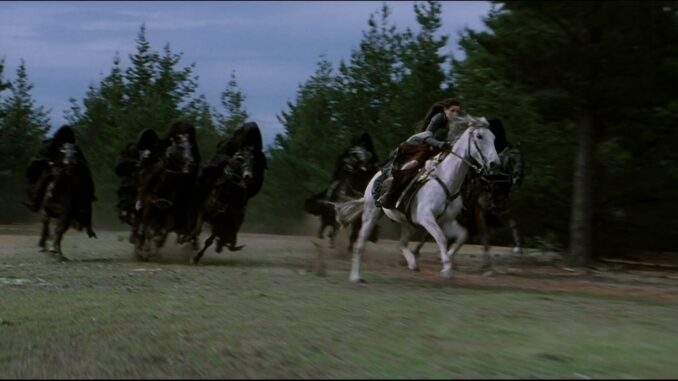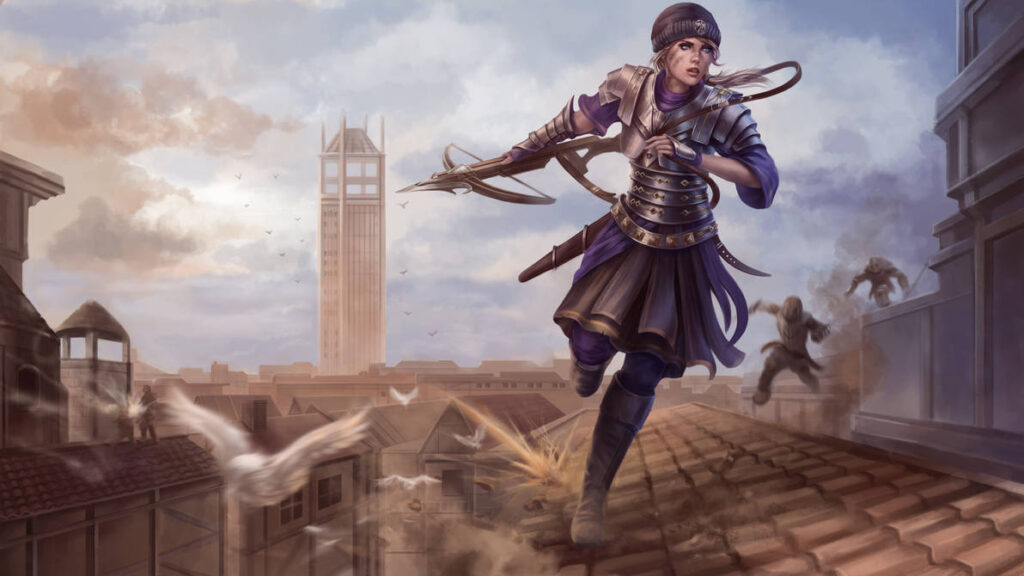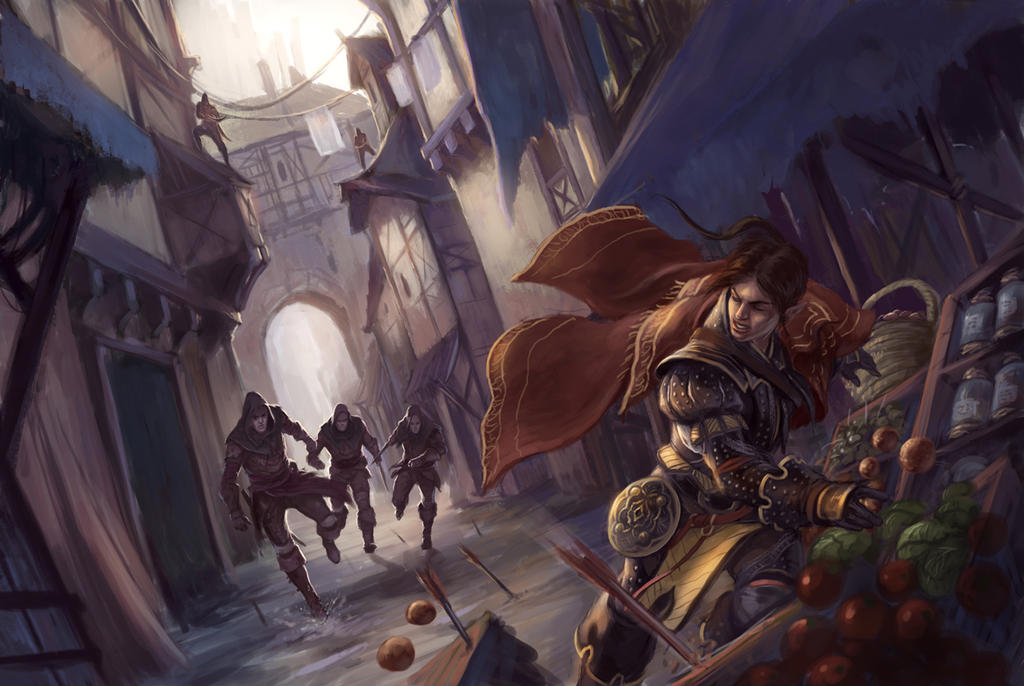
Chases are boring in Dungeons and Dragons Fifth Edition. There are some basic mechanics listed in the Dungeon Masters Guide, but they are somewhat… lacking. They’re very bare bones and don’t allow for a lot of variety in a character’s actions. The rules are written in such a way that it becomes a case of each side using the Dash action until the side with the lower Constitution score exhausts itself or until spells can be cast to immobilize the other side.
That’s just not very fun as far as I’m concerned. Chases should be frantic and cinematic and that doesn’t necessarily work when it’s contained to something like a battle map and movement speeds. And while I’m not necessarily breaking any new ground by talking about creating some house rules for this type of action, I haven’t yet chanced across any that really strike my fancy – they either over complicate the rules from the DMG without really improving the fun of the chase or introduce entirely new systems. So I wanted take a look at this and see if we can figure out some new rules for chases by using a system that I believe does it quite well – Savage Worlds – for inspiration and add as few rules to the idea as possible.
Step One – Establish the Scene
This one may seem a given, but it’s also a very important step in order to make sure sure that everyone is picturing the same thing. Is the chase taking place through crowded city streets during market hours? Across the rooftops of a busy industrial district with stacks belching smoke and caustic chemicals into the air? Are they chasing the enemy through the cars of a lightning rail to catch them before they can sabotage the crew cart and release the air elemental powering the vehicle? This not only sets the scene but also helps the players imagine the stakes.
Step Two – Set up the Chase Track
Lay out a number of index cards or playing cards to show the Chase Track. This is something of an abstraction in order to visualize a chase in a way that a normal battle map would not be able to contain and allows for fast and frantic jockeying of position. Each card represents a “zone” that the individual chase participants move through as they chase (or flee from) the other party from left to right. The number of cards you deal out will determine how long the chase will take. Nine cards is probably good for a standard chase, but can be shortened or lengthened as necessary. During this step, it’s also important to set a scale for each card. If the chase is completely on foot, each zone may only be 30 feet. It may be more in the case of wide open spaces or if the participants are mounted on creatures or riding vehicles. This helps determine how close characters need to be to bring spells and ranged weapons into the equation.
Step Three – Establish Starting Positions
Based on the fiction determine the relative starting positions of each character involved in the chase. The character(s) who is the furthest behind starts at the last card and everyone else gets placed ahead of them on the Chase Track as determined by the DM. Likely the pursued are several zones ahead (or there wouldn’t be a need for this mechanic and it could be solved by a battle).
Step Four – Determine Initiative
As normal, determine the initiative order each character will act in.

Step Five – Run the Chase
Character actions are slightly different in a chase, since they are assumed to be constantly moving. As such they have don’t need to move their speed during a chase. They still get an Action and possible Bonus Action, but the nature of the chase changes how certain actions function and also gives them access to additional choices.
Attack. A character may only use a melee weapon if they are in the same zone on the Chase Track as their target. Ranged attacks can only be made within the weapon’s first range increment and are made at disadvantage. If you are firing from a stable platform, normal rules for range applies.
Board (Vehicles Only). At attacker can attempt to grapple the other parties vehicle and conduct a boarding action. In order to attempt this, they must be on the same zone of the Chase Track. Both vehicles make opposed maneuvering checks – if the attacker is successful they have joined the two vessels (by grappling hooks or something similar) and crew may board the enemy craft. The captured vehicle may only attempt to Change Position (see below) at a disadvantage and if successful, they are no longer grappled and can continue to flee, though they may still have enemy boarders in their midst.
Cast a Spell. A character may cast a spell at anyone they can see and within range of the spell. If the spell requires an attack roll, it is made at disadvantage unless the character is on some sort of stable platform as the character is casting the spell while on the run and unable to aim as well as if they could stop and plant themselves.
Change Position (Free Action or Action). A character can attempt to advance across the Chase Track in order to close in on their quarry (or move further away from their pursuers) by making what is called a maneuvering check. This maneuvering check is determined by the nature of the chase. If the participant is on foot, this will be an Athletics or Acrobatics checks. If controlling a vehicle the driver will roll the appropriate proficiency skill. If mounted they should roll an Animal Handling check. Succeeding at a DC 11 check means they move forward one card on the chase track. If they make a DC 16 check, they instead move forward two spaces on the chase track. Failure means that they do not move from their current zone, and rolling a natural 1 means they suffer a complication. If the players decide to use their Action on this maneuvering check they get to roll the appropriate skill with advantage.
Dropping Back. In a linear chase only a character may drop back one or two zones on the Chase Track, without making a maneuvering roll, but cannot take the Change Position for the rest of the round.
Dash. The Dash action functions differently than normal. If you make the Dash action, you move forward one zone on the Chase Track but must make a DC 11 Constitution saving throw. If you fail, you gain a level of exhaustion. Each time you use the Dash action in a chase the DC of the saving throw increases by a cumulative +1.
Dodge (Free Action or Action). The Dodge action functions differently than normal. By using the terrain to maximize cover and otherwise zigzag through obstacles you can make yourself very difficult to target with attacks. By taking a Free Action you grant yourself half cover against attacks made against you until the beginning of your next turn. If you take a full action, you grant yourself three-quarters cover instead.
Flee. A character or vehicle can attempt to escape the chase as long as there are at least four zones on the Chase Track between themselves and the closest foe. They make a maneuvering check at disadvantage and escape from the chase if successful. If there are five or more zones on the Chase Track between themselves and the closest foe, they only make the maneuvering check at a -2 penalty. If there are six or more zones between themselves and the closest foe, they make the maneuvering check with no penalty.
Force. A character can attempt to force another participant or vehicle away from them or into an obstacle. To do so, they must be in the same zone of the Chase Track and make opposed maneuvering checks. If the attacker is successful, they may move their target one zone in any direction they choose on the Chase Track. If the attacker rolls a natural 20 on this roll, the defender also suffers from a complication. However, if the attacker rolls a natural 1, they themselves suffer from the complication instead.
Help. This action functions as normal. If you are attempting to use the Help action to feint, you must be in the same zone on the Chase Track as your target.
Hold Steady (Free Action – Driver Only). The driver of a vehicle may hold steady to allow others on board to line up a better shot. Anyone making a ranged attack until the start of the driver’s next turn is treated as having a stable platform and thus doesn’t take any penalties on their attack rolls. However, any attacks targeting the vehicle until the beginning of the driver’s next turn (or any riders that can be targeted) are made with advantage.
Ram. An attacker can attempt this high risk maneuver against a defender if they’re on the same zone of the Chase Track by making opposed maneuvering rolls. If the attacker is successful, both participants cause damage to each other based on the size of the attacker – Tiny 1d3, Small 1d4, Medium 1d6, Large 1d10, Huge 2d8, Colossal 4d10, Gargantuan 6d10. If the attack fails, it suffers half the damage it would have caused on a success. A roll of a 1 on the maneuvering track also means that the attack is forced back a zone on the Chase Track as they careen out of control.
Ready. This action works as normal and is usually gets more use from the pursued than the pursuers who can ready Force actions to bump targets back if they close into the same zone on the Chase Track, but characters might find other uses for this, especially if they are on board vehicles and need to get in range to fire weapons.
Use an Object. This action functions as normal.
Complications.
Several of these entries speak of “complications” should certain dice results turn up when a character attempts certain actions. This is left open to the DM’s interpretation to fit the scene, but should result in some condition or setback levied against the character that they will have to use their next Action in order to attempt to clear. If the chase is taking place through crowded city streets they become Restrained as they plunge into an especially tight knot of pedestrians and they will have to attempt a Strength check to break free of the crowd on their next turn. If they are on a vehicle, it pitches in such a way where the deck comes out from under their feet and they are knocked prone and will have to use their action next round to get back up before they can do anything. A DM could even make a list of potential complications for their chase if they so desire or create some generic complication tables based on various settings (urban, aerial, plains, caves, etc). If they must make some kind of roll, the DC for the check is an 11.

Other Chase Considerations
There are a few other things to take into considering with chases. The first is that you do not get to make opportunity attacks against creatures that move out of your zone on the Chase Track. Secondly, this is meant to be a fluid system that can change as the chase goes on. If the quarry reaches the end of the Chase Track but there is no chance at resolution, feel free to lay down more cards and extend the chase further, but change up the scene – now instead of crowded city streets it’s now spilled into a maze of alleyways leading deeper and deeper into the slums. Maybe the quarry splits up and a second Chase Track extends out forcing the pursuers to also split up. Maybe the chase attracted the attention of the city guard and now there’s a third group in the chase attempting to capture everyone involved. Maybe the quarry just needs to get to the end of the Chase Track to accomplish their goal such as sabotaging the crew cabin of a lightning rail or reach their stronghold where they will be protected. In such a case, they don’t have to flee, they just have to beat their pursuers back to the end of the Chase Track.
Finally, this system could likely easily be adapted for things like naval warfare (or infernal war machines or even spelljammers). Instead of a linear track, lay out a Chase Track of cards in a 4×4 pattern and let the participating ships jockey for position within that battlefield. And I’m sure there’s even more uses that a clever DM could find a use for in their own game.
So there you have my proposal – now, these rules haven’t been tested yet, but I do have an Eberron game that has just started that I think will be able to benefit from these rules very very soon. I’m excited to try them. At the very least they feel more fun and cinematic than what is presented in the Dungeon Masters Guide.
